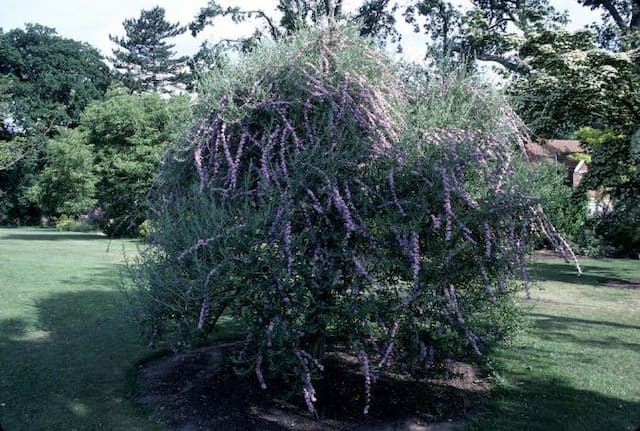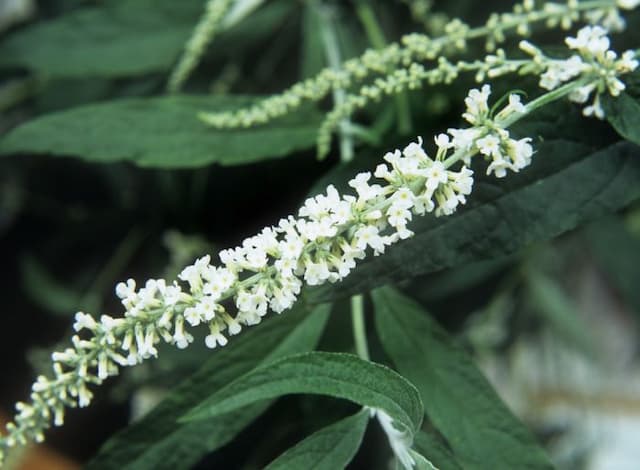Butterfly Bush Buddleja 'Pink Delight'

ABOUT
The Buddleja 'Pink Delight', commonly known as the Butterfly Bush due to its attractiveness to butterflies, is a deciduous shrub that is highly appreciated for its ornamental qualities. It features lance-shaped leaves that have a soft grayish-green hue, providing a subtle backdrop for its showy flowers. The most striking aspect of the Butterfly Bush is its abundant clusters of vivid pink flowers, which are small, tubular, and gathered in dense, elongated cones at the branch tips. These blossoms have a delightful fragrance that contributes to their allure for pollinators such as butterflies and bees. The flowers bloom profusely throughout the summer and into the fall, offering a prolonged display of color. Their pink hue is a cheerful, bright shade that can act as a focal point in a garden setting. The overall shape of the Butterfly Bush is somewhat sprawling, with arching branches that give it a casual and somewhat wild appearance. As the branches sway in the breeze, the flowers create a dynamic and fluid spectacle, softening the look of the landscape and adding movement. This shapely demeanor, coupled with its colorful and fragrant flowers, makes the Butterfly Bush 'Pink Delight' a popular choice for gardeners wanting to create an inviting habitat for wildlife while also adding a splash of color to their garden palette.
About this plant
 Names
NamesSynonyms
Pink Delight Butterfly Bush, Pink Delight Summer Lilac
Common names
Buddleja davidii 'Pink Delight'.
 Toxicity
ToxicityTo humans
The Butterfly Bush is generally not considered toxic to humans. There are no well-documented cases or reports of significant poisoning in humans from ingesting parts of the Butterfly Bush. As with any plant, individual sensitivities can vary, and it is always advisable to avoid eating any parts of ornamental plants due to potential unknown allergies or reactions.
To pets
The Butterfly Bush is not known to be toxic to pets either. It is not listed as a toxic plant to dogs or cats by the ASPCA. However, it is still not recommended that pets consume this or any ornamental plant as it could potentially cause mild stomach upset due to the plant material that is not meant to be part of their diet. If a large amount is ingested, it is best to watch for any signs of gastrointestinal discomfort and contact a veterinarian if any concerning symptoms arise.
 Characteristics
CharacteristicsLife cycle
Perennials
Foliage type
Deciduous
Color of leaves
Green
Flower color
Pink
Height
6 feet (1.83 meters)
Spread
4 feet (1.22 meters)
Plant type
Shrub
Hardiness zones
5-9
Native area
Asia
Benefits
 General Benefits
General Benefits- Attracts Pollinators: Buddleja 'Pink Delight' is highly attractive to butterflies, bees, and other beneficial insects, thus promoting biodiversity in the garden.
- Easy to Grow: This plant is known for being low-maintenance and easy to cultivate, making it appealing for both new and experienced gardeners.
- Drought Tolerant: Once established, Buddleja 'Pink Delight' is fairly drought-resistant, reducing the need for frequent watering.
- Fast Growing: It has a rapid growth rate, allowing gardeners to enjoy its flowers relatively quickly after planting.
- Long Blooming Season: The plant blooms for an extended period, usually from early summer to early autumn, providing long-lasting visual interest.
- Landscape Beautification: With its bright pink flowers and lush foliage, it contributes significantly to the aesthetic appeal of landscaping projects.
- Wildlife Habitat: The shrub can act as a habitat and food source for wildlife, particularly for nectar-feeding insects.
- Versatility of Use: Suitable for use in mixed borders, as a focal point, or even in large containers for patios and decks.
- Privacy Screen: Its growth habit allows it to be used as an informal hedge or privacy screen in gardens.
- Pruning Tolerant: It responds well to pruning, which can help maintain a desired shape and size, and promote vigorous blooming.
 Medical Properties
Medical PropertiesThis plant is not used for medical purposes.
 Air-purifying Qualities
Air-purifying QualitiesThis plant is not specifically known for air purifying qualities.
 Other Uses
Other Uses```html
- Crafting Dyes: The flowers of the Butterfly Bush can be used to create natural dyes for textiles, yielding subtle shades of pink and purple depending on the mordant used.
- Photography Subject: With its bright pink blooms, Butterfly Bush is an excellent subject for nature photographers and botanical illustrators looking to capture its stunning color and form.
- Garden Themes: Butterfly Bush is commonly used in thematic gardens, such as fairy or cottage gardens, due to its whimsical appearance and attractiveness to butterflies.
- Educational Tool: Butterfly Bush can be used in educational settings to teach students about pollination and the importance of supporting pollinator populations.
- Livestock Fodder: In some cases, the Butterfly Bush leaves can be used as fodder for livestock, although this is not a common use and care should be taken due to possible toxicity.
- Floral Arrangements: The long-lasting flowers of the Butterfly Bush can be utilized in cut floral arrangements, adding a splash of color to bouquets and indoor displays.
- Artisanal Paper Making: Butterfly Bush flowers and stems can be incorporated into the paper-making process to create decorative, textured papers with botanical inclusions.
- Natural Potpourri: Dried Butterfly Bush blooms can be included in potpourri mixes to add a pleasant fragrance and color to a room.
- Event Decor: Butterfly Bush branches can be used to create natural, biodegradable decor for weddings and other events, particularly in outdoor settings.
- Wildlife Habitat: The dense foliage of the Butterfly Bush can provide shelter and nesting sites for small birds and beneficial insects in a garden ecosystem.
Interesting Facts
 Feng Shui
Feng ShuiThe Butterfly Bush is not used in Feng Shui practice.
 Zodiac Sign Compitability
Zodiac Sign CompitabilityThe Butterfly Bush is not used in astrology practice.
 Plant Symbolism
Plant Symbolism- Transformation: The Buddleja, commonly known as the Butterfly Bush, symbolizes transformation and change, much like the butterflies it attracts, which are emblematic of metamorphosis.
- New Beginnings: Growing rapidly and flowering profusely, the Butterfly Bush can represent fresh starts and the beginning of something beautiful.
- Attraction: As the plant is known for attracting a variety of insects and birds, it symbolizes allure and an ability to draw in positivity and good influences.
- Rebirth: The Butterfly Bush often rejuvenates itself after being cut back, symbolizing resilience and the ability to recover and flourish even after facing adversity.
- Inspiration: Buddleja 'Pink Delight' specifically, with its vibrant pink blooms, is often associated with creativity and inspiration, uplifting spirits and encouraging the flow of new ideas.
 Water
WaterFor the Butterfly Bush 'Pink Delight', it is essential to keep the soil consistently moist, especially during its first growing season to establish a deep root system. Watering should be done deeply rather than frequently, which might mean using about 1 gallon per plant every week during the warm season. Reduce watering to half a gallon every other week in cooler weather or during periods when rainfall is sufficient. Ensure that the soil drains well to prevent waterlogging, as the Butterfly Bush does not like soggy roots. In periods of extreme heat or drought, increase the amount of water slightly to maintain soil moisture.
 Light
LightThe Butterfly Bush 'Pink Delight' thrives best in full sun, where it can receive at least 6 to 8 hours of direct sunlight daily. It is important to place this plant in a sunny location in the garden, as maximum sun exposure encourages more prolific blooming. Avoid heavily shaded areas as this will reduce flowering and can make the plant leggy and less robust.
 Temperature
TemperatureButterfly Bush 'Pink Delight' is reasonably hardy and can withstand temperatures down to about 20°F but may suffer dieback in colder climates. It flourishes in a range of temperatures from 60°F to 85°F, which are ideal conditions for growth and flowering. Ensure that you provide some winter protection if temperatures regularly fall below the minimum range.
 Pruning
PruningPruning the Butterfly Bush 'Pink Delight' helps maintain its shape, encourage bushier growth, and promote more vibrant blooms. It is best to prune in late winter or early spring before new growth begins, cutting back the plant to about a foot or two from the ground. This can be done annually, as the Butterfly Bush blooms on new wood and responds well to hard pruning.
 Cleaning
CleaningAs needed
 Soil
SoilButterfly Bush 'Pink Delight' thrives in well-draining soil enriched with organic matter, such as compost or well-rotted manure. A balanced potting mix with a pH level ranging between 6.0 and 7.0 is ideal, ensuring the soil is neither too acidic nor too alkaline.
 Repotting
RepottingButterfly Bush 'Pink Delight' does not require frequent repotting; it should be repotted every 2-3 years to refresh the soil and accommodate the root growth.
 Humidity & Misting
Humidity & MistingButterfly Bush 'Pink Delight' is quite adaptable to various humidity levels but prefers a moderate humidity environment. It does not have specific humidity requirements and can thrive in average outdoor humidity levels.
 Suitable locations
Suitable locationsIndoor
Provide full sun, well-drained soil, and prune for shape.
Outdoor
Ensure full sun, prune annually, and protect from harsh winds.
Hardiness zone
5-9 USDA
 Life cycle
Life cycleBuddleja 'Pink Delight', commonly known as the Butterfly Bush, begins its life cycle as a seed, which germinates in warm, well-drained soil in the spring. The seedling emerges and develops into a small plant with characteristic lanceolate leaves and begins to establish a root system. As it matures during the growing season, it undergoes rapid vegetative growth, eventually forming a woody structure and flowering in mid to late summer, with panicles of pink flowers that attract butterflies and other pollinators. After pollination, the flowers produce small capsules containing seeds, which are dispersed by wind or, less commonly, by animals. In temperate climates, the Butterfly Bush becomes dormant in the fall, with above-ground growth dying back with the onset of winter, while the roots remain alive below ground. The plant resumes growth from its rootstock the following spring, continuing its perennial cycle.
 Propogation
PropogationPropogation time
Spring-Early Summer
The Buddleja 'Pink Delight', commonly known as Butterfly Bush, can be propagated through semi-hardwood cuttings during the summer months, which is typically the most popular and successful method. To do this, gardeners should select a healthy parent plant and take a cutting of about 4 to 6 inches (10 to 15 cm) in length from the current season's growth. The bottom leaves are removed, and the cut end is dipped in rooting hormone to encourage root development. The cutting should then be placed in a pot filled with a mixture of peat and perlite or a good quality potting mix. It's important to maintain moisture and provide indirect light until roots have developed, which usually takes a few weeks to a couple of months. Once the cutting has rooted, it can be transplanted into the garden or a larger pot for further growth.



![Butterfly bush [Florence]](/_next/image?url=https%3A%2F%2Fplants-admin.emdemapps.com%2Fimages%2Fplants%2F%2Fimages%2F604b5f52d7bb1.png&w=640&q=75)
![Butterfly bush [Nanho Blue]](/_next/image?url=https%3A%2F%2Fplants-admin.emdemapps.com%2Fimages%2Fplants%2F%2Fimages%2F604b55d0a6d2d.png&w=640&q=75)




